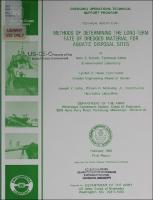Please use this identifier to cite or link to this item:
https://hdl.handle.net/11681/4658Full metadata record
| DC Field | Value | Language |
|---|---|---|
| dc.contributor.author | Dortch, Mark S. | en_US |
| dc.contributor.author | Hales, Lyndell Z. | en_US |
| dc.contributor.author | Letter, Joseph V. | en_US |
| dc.contributor.author | McAnally, William H. | en_US |
| dc.creator | Coastal Engineering Research Center (U.S.) | en_US |
| dc.creator | Dredging Operations Technical Support Program (U.S.) | en_US |
| dc.creator | Hydraulics Laboratory (U.S.) | en_US |
| dc.creator | Environmental Laboratory (U.S.) | en_US |
| dc.date.accessioned | 2016-03-16T22:17:57Z | en_US |
| dc.date.available | 2016-03-16T22:17:57Z | en_US |
| dc.date.issued | 1990-02 | en_US |
| dc.identifier.govdoc | Technical Report D-90-1 | en_US |
| dc.identifier.uri | http://hdl.handle.net/11681/4658 | en_US |
| dc.description | Technical Report | en_US |
| dc.description.abstract | To manage an open-water dredged material disposal site, it is essential to know the physical capacity of the site (i.e., how much material should be dumped at the site and what the capability is of the material to remain onsite under various environmental conditions of waves and currents). Long-term management of aquatic disposal sites also requires an understanding of how much area the disposal mound encompasses, when the mound encroaches on the site boundaries, how much material leaves the site, and perhaps where the material ultimately goes. The purpose of this report is to identify methods that can be used to develop information concerning the long-term fate of dredged material disposed at aquatic sites. The methods are broken into two major categories: (A.) methods of analysis for mound resuspension and dynamics and (B.) methods of analysis for transport and redeposition of mound material. For each of these two categories, four basic approaches are reviewed: (1.) steady-state analytical methods; (2.) time- and rate-dependent analytical methods; (3.) physical and numerical modeling; and (4.) measurements through field and laboratory studies. Other sections of the report are devoted to discussions of physical processes and study recommendations. Additional details of the methods of analysis are provided in four appendixes. | en_US |
| dc.description.sponsorship | Dredging Operations Technical Support Program (U.S.) | en_US |
| dc.description.sponsorship | United States. Army. Corps of Engineers | en_US |
| dc.description.tableofcontents | Preface.....................1 Conversion Factors, Non-SI to SI (Metric) Units of Measurement.....................4 Part I: Introduction.....................5 Background.....................5 Purpose and Scope.....................5 Part II: Process Descriptions.....................8 Short-Term Fate and Mound Formation.....................8 Resuspension of Mound Material.....................19 Transport and Redeposition of Mound Material.....................24 Part III: Methods of Analysis for Mound Resuspension and Dynamics.....................29 Requirements for Resuspension.....................29 Steady-State Analytical Methods.....................49 Time- and Rate-Dependent Analytical Methods.....................61 Modeling.....................68 Field and Laboratory Studies.....................76 Part IV: Methods of Analysis for Transport and Redeposition of Mound Material.....................88 Steady-State Analytical Methods.....................88 Time- and Rate-Dependent Analytical Methods.....................95 Modeling.....................100 Field and Laboratory Studies.....................109 Part V: Recommendations Part VI: Summary.....................113 Purpose of the Study.....................113 Process Descriptions.....................114 Steady-State Analytical Methods.....................128 Time- and Rate-Dependent Analytical Methods.....................135 Modeling.....................138 Field and Laboratory Studies.....................143 Recommendations.....................148 References.....................151 Appendix A: Field and Laboratory Tests.....................A1 Field Tests.....................A2 Laboratory Tests.....................A8 Appendix B: Physical Modeling.....................B1 Use of Physical Models.....................B1 Advantages and Disadvantage of Physical Models.....................B4 Field Data Requirements.....................B5 Verification.....................B11 Time and Cost Estimates.....................B15 Appendix C: Numerical Models.....................C1 Uses of Numerical Models.....................C1 Available of Numerical Models.....................C2 Advantages and Disadvantage of Numerical Models.....................C7 Field Data Requirements.....................C9 Time and Cost Estimates.....................C12 Appendix D: Hybrid Models.....................D1 | en_US |
| dc.format.extent | 204 pages/39.08 MB | en_US |
| dc.format.medium | en_US | |
| dc.language.iso | en_US | en_US |
| dc.publisher | U.S. Army Engineer Waterways Experiment Station | en_US |
| dc.relation | http://acwc.sdp.sirsi.net/client/en_US/search/asset/1036387 | en_US |
| dc.relation.ispartofseries | Technical Report (Dredging Operations Technical Support Program (U.S.)) ; no.Technical Report D-90-1 | en_US |
| dc.rights | Approved for public release; distribution is unlimited | en_US |
| dc.source | This Digital Resource was created from scans of the Print Resource | en_US |
| dc.subject | Aquatic disposal sites | en_US |
| dc.subject | Disposal mound | en_US |
| dc.subject | Dredged material | en_US |
| dc.subject | Long-term fate | en_US |
| dc.subject | Sediment resuspension | en_US |
| dc.subject | Sediment transport | en_US |
| dc.subject | Site capacity | en_US |
| dc.subject | Dredging spoil | en_US |
| dc.subject | Marine pollution | en_US |
| dc.subject | Aquatic pollution | en_US |
| dc.subject | Suspended sediments | en_US |
| dc.subject | Dredging Operations Technical Support Program (U.S.) | en_US |
| dc.title | Methods of determining the long-term fate of dredged material for aquatic disposal sites | en_US |
| dc.type | Report | en_US |
| Appears in Collections: | Technical Report | |
Files in This Item:
| File | Description | Size | Format | |
|---|---|---|---|---|
| TR-D-90-1.pdf | Technical Report D-90-1 | 39.08 MB | Adobe PDF |  View/Open |